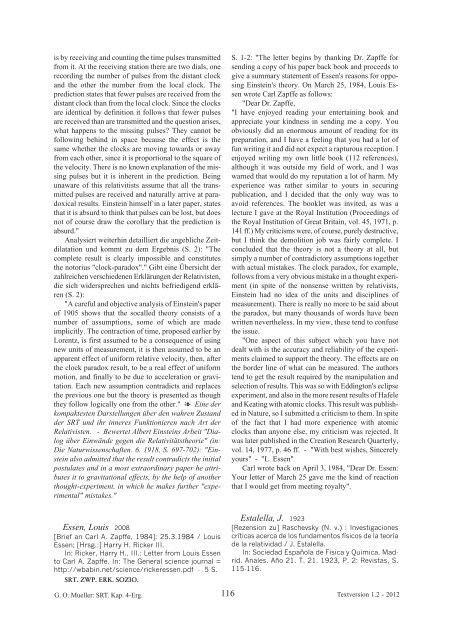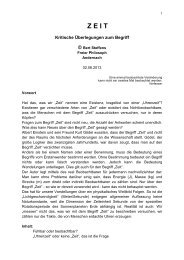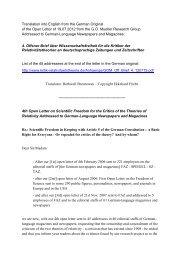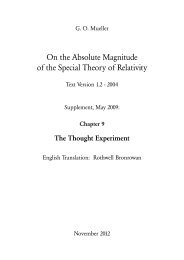2394 weitere kritische Veröffentlichungen - Kritische Stimmen zur ...
2394 weitere kritische Veröffentlichungen - Kritische Stimmen zur ...
2394 weitere kritische Veröffentlichungen - Kritische Stimmen zur ...
Erfolgreiche ePaper selbst erstellen
Machen Sie aus Ihren PDF Publikationen ein blätterbares Flipbook mit unserer einzigartigen Google optimierten e-Paper Software.
is by receiving and counting the time pulses transmitted<br />
from it. At the receiving station there are two dials, one<br />
recording the number of pulses from the distant clock<br />
and the other the number from the local clock. The<br />
prediction states that fewer pulses are received from the<br />
distant clock than from the local clock. Since the clocks<br />
are identical by definition it follows that fewer pulses<br />
are received than are transmitted and the question arises,<br />
what happens to the missing pulses? They cannot be<br />
following behind in space because the effect is the<br />
same whether the clocks are moving towards or away<br />
from each other, since it is proportional to the square of<br />
the velocity. There is no known explanation of the missing<br />
pulses but it is inherent in the prediction. Being<br />
unaware of this relativitists assume that all the transmitted<br />
pulses are received and naturally arrive at paradoxical<br />
results. Einstein himself in a later paper, states<br />
that it is absurd to think that pulses can be lost, but does<br />
not of course draw the corollary that the prediction is<br />
absurd."<br />
Analysiert weiterhin detailliert die angebliche Zeitdilatation<br />
und kommt zu dem Ergebnis (S. 2): "The<br />
complete result is clearly impossible and constitutes<br />
the notorius "clock-paradox"." Gibt eine Übersicht der<br />
zahlreichen verschiedenen Erklärungen der Relativisten,<br />
die sich widersprechen und nichts befriedigend erklären<br />
(S. 2):<br />
"A careful and objective analysis of Einstein's paper<br />
of 1905 shows that the socalled theory consists of a<br />
number of assumptions, some of which are made<br />
implicitly. The contraction of time, proposed earlier by<br />
Lorentz, is first assumed to be a consequence of using<br />
new units of measurement, it is then assumed to be an<br />
apparent effect of uniform relative velocity, then, after<br />
the clock paradox result, to be a real effect of uniform<br />
motion, and finally to be due to acceleration or gravitation.<br />
Each new assumption contradicts and replaces<br />
the previous one but the theory is presented as though<br />
they follow logically one from the other." � Eine der<br />
kompaktesten Darstellungen über den wahren Zustand<br />
der SRT und ihr inneres Funktionieren nach Art der<br />
Relativisten. - Bewertet Albert Einsteins Arbeit "Dialog<br />
über Einwände gegen die Relativitätstheorie" (in:<br />
Die Naturwissenschaften. 6. 1918, S. 697-702): "Einstein<br />
also admitted that the result contradicts the initial<br />
postulates and in a most extraordinary paper he attributes<br />
it to gravitational effects, by the help of another<br />
thought-experiment, in which he makes further "experimental"<br />
mistakes."<br />
Essen, Louis 2008<br />
[Brief an Carl A. Zapffe, 1984]: 25.3.1984 / Louis<br />
Essen; [Hrsg.:] Harry H. Ricker III.<br />
In: Ricker, Harry H., III.: Letter from Louis Essen<br />
to Carl A. Zapffe. In: The General science journal =<br />
http://wbabin.net/science/rickeressen.pdf - 5 S.<br />
SRT. ZWP. ERK. SOZIO.<br />
G. O. Mueller: SRT. Kap. 4-Erg.<br />
116<br />
S. 1-2: "The letter begins by thanking Dr. Zapffe for<br />
sending a copy of his paper back book and proceeds to<br />
give a summary statement of Essen's reasons for opposing<br />
Einstein's theory. On March 25, 1984, Louis Essen<br />
wrote Carl Zapffe as follows:<br />
"Dear Dr. Zapffe,<br />
"I have enjoyed reading your entertaining book and<br />
appreciate your kindness in sending me a copy. You<br />
obviously did an enormous amount of reading for its<br />
preparation, and I have a feeling that you had a lot of<br />
fun writing it and did not expect a rapturous reception. I<br />
enjoyed writing my own little book (112 references),<br />
although it was outside my field of work, and I was<br />
warned that would do my reputation a lot of harm. My<br />
experience was rather similar to yours in securing<br />
publication, and I decided that the only way was to<br />
avoid references. The booklet was invited, as was a<br />
lecture I gave at the Royal Institution (Proceedings of<br />
the Royal Institution of Great Britain, vol. 45, 1971, p.<br />
141 ff.) My criticisms were, of course, purely destructive,<br />
but I think the demolition job was fairly complete. I<br />
concluded that the theory is not a theory at all, but<br />
simply a number of contradictory assumptions together<br />
with actual mistakes. The clock paradox, for example,<br />
follows from a very obvious mistake in a thought experiment<br />
(in spite of the nonsense written by relativists,<br />
Einstein had no idea of the units and disciplines of<br />
measurement). There is really no more to be said about<br />
the paradox, but many thousands of words have been<br />
written nevertheless. In my view, these tend to confuse<br />
the issue.<br />
"One aspect of this subject which you have not<br />
dealt with is the accuracy and reliability of the experiments<br />
claimed to support the theory. The effects are on<br />
the border line of what can be measured. The authors<br />
tend to get the result required by the manipulation and<br />
selection of results. This was so with Eddington's eclipse<br />
experiment, and also in the more resent results of Hafele<br />
and Keating with atomic clocks. This result was published<br />
in Nature, so I submitted a criticism to them. In spite<br />
of the fact that I had more experience with atomic<br />
clocks than anyone else, my criticism was rejected. It<br />
was later published in the Creation Research Quarterly,<br />
vol. 14, 1977, p. 46 ff. - "With best wishes, Sincerely<br />
yours" - "L. Essen"<br />
Carl wrote back on April 3, 1984, "Dear Dr. Essen:<br />
Your letter of March 25 gave me the kind of reaction<br />
that I would get from meeting royalty".<br />
Estalella, J. 1923<br />
[Rezension zu] Raschevsky (N. v.) : Investigaciones<br />
críticas acerca de los fundamentos físicos de la teoría<br />
de la relatividad / J. Estalella.<br />
In: Sociedad Española de Fisica y Quimica. Madrid.<br />
Anales. Año 21. T. 21. 1923, P. 2: Revistas, S.<br />
115-116.<br />
Textversion 1.2 - 2012





